There are more
than 40,000 varieties of cultivated rice (the grass species Oryza
sativa) said to exist. But the exact figure is uncertain. Over 90,000
samples of cultivated rice and wild species are stored at the
International Rice Gene Bank and these are used by researchers all over
the world.
The rice varieties can be divided into 2 basic groups, Long grain; and all purpose & speciliaty.
Types of Rice
Rice is a staple in any kitchen, and with so many different types, it lends itself to a limitless number of recipes. Before you add the same type of rice to every recipe you prepare, however, think twice. Substituting one type of rice for another can really alter the result of a recipe. Each type of rice has its own taste, texture, and unique properties that work well with different cooking applications. So how do you know which one to choose? This guide examines factors that differentiate types of rice, from nutty basmati to fragrant jasmine and more!
Glossary
The following anatomy terms may be used throughout this guide when discussing the differences in types of rice.
 Hull - Each grain of rice is enclosed in a tough outer hull, or husk, that needs to be removed before it can be consumed. This layer is removed in all rice types.
Hull - Each grain of rice is enclosed in a tough outer hull, or husk, that needs to be removed before it can be consumed. This layer is removed in all rice types.
Bran - Under the hull, the bran layer is not removed in all rice types. This nutritious whole grain section is usually tan-colored, but it may be reddish or black depending on the pigmentation in the bran layers. The bran layer may be consumed, but it is often removed when further processing rice.
White Rice - Once the bran and germ layers are removed, white rice remains. Known as the endosperm, this is the part of the rice that is most commonly consumed.
Germ - Found under the hull, the germ, or rice kernel, is nutrient-dense. Full of B vitamins, minerals, and proteins, it helps give rice its color and added nutritional benefits.
Types of Rice
Length and Shape
Rice is often characterized as one of three varieties - long grain, medium grain, or short grain rice. These varieties refer to the length and shape of the grain. Simply speaking, long grain rice will have a longer cylindrical shape, whereas short grain rice will be shorter and wider.
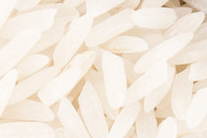 Long Grain Rice - This rice has milled grains that are at least three to four times as long as they are wide. Due to its starch composition, it is separate, light and fluffy when cooked.
Long Grain Rice - This rice has milled grains that are at least three to four times as long as they are wide. Due to its starch composition, it is separate, light and fluffy when cooked.
 Medium Grain Rice - When compared to long grain rice, medium grain rice has a shorter, wider kernel. Since the cooked grains are more moist and tender than long grain rice, the rice has a greater tendency to stick together.
Medium Grain Rice - When compared to long grain rice, medium grain rice has a shorter, wider kernel. Since the cooked grains are more moist and tender than long grain rice, the rice has a greater tendency to stick together.
Short Grain Rice - Featuring grains that are less than twice as long as they are wide, this rice is short and best for sushi. It has a sticky texture when cooked.
Texture
When cooking rice dishes, you'll want to think about the desired texture of the rice. The starch content varies from rice type to rice type. It will affect whether rice is sticky or light and fluffy.
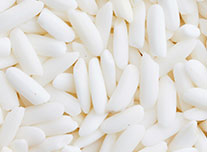 Sticky Rice - Also known as sweet rice, sticky rice is grown mainly in Southeast and East Asia and is used in many traditional Asian dishes, desserts, and sweets. When cooked, sticky rice is especially sticky and is often ground into rice flour.
Sticky Rice - Also known as sweet rice, sticky rice is grown mainly in Southeast and East Asia and is used in many traditional Asian dishes, desserts, and sweets. When cooked, sticky rice is especially sticky and is often ground into rice flour.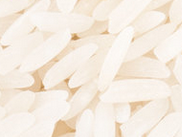 Parboiled Rice - This “rough” rice has gone through a steam-pressure process before milling that gelatinizes the starch in the grain. This process produces a more separate grain that is light and fluffy when cooked. Converted rice is a type of parboiled rice that has been further pre-cooked, which ultimately allows you to whip up dishes of rice even faster.
Parboiled Rice - This “rough” rice has gone through a steam-pressure process before milling that gelatinizes the starch in the grain. This process produces a more separate grain that is light and fluffy when cooked. Converted rice is a type of parboiled rice that has been further pre-cooked, which ultimately allows you to whip up dishes of rice even faster.
Color
Rice is naturally brown after harvesting, but once the nutrient-rich outer layer of bran is removed, it is white in color. Red rice, black rice, and purple rice all feature unique pigmentation in the bran. For these colorful rice varieties, the bran layer usually remains for added visual appeal and added nutritional value.
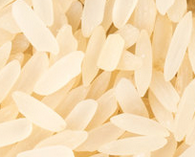 Polished Rice - The term “polished” simply refers to white rice that has had its outer brown layer of bran and germ removed. Rice that has shed its bran layers can also be referred to as "milled rice."
Polished Rice - The term “polished” simply refers to white rice that has had its outer brown layer of bran and germ removed. Rice that has shed its bran layers can also be referred to as "milled rice."
Brown Rice - This healthful rice sheds its outer husk and retains its bran and germ layers that give it a characteristic tan color. Though brown rice takes a little longer to cook than white rice, the nutrient-dense layers are rich in vitamins and minerals.
 Forbidden Rice - High in nutritional value, this rice is also known as black rice and has a mild nutty flavor. Slightly sticky when cooked, it is used in a variety of Chinese or Thai dishes, including Chinese black rice cake and mango sticky rice. Mix it with white rice, and it also adds color to any rice pilaf or rice bowl.
Forbidden Rice - High in nutritional value, this rice is also known as black rice and has a mild nutty flavor. Slightly sticky when cooked, it is used in a variety of Chinese or Thai dishes, including Chinese black rice cake and mango sticky rice. Mix it with white rice, and it also adds color to any rice pilaf or rice bowl.
Wild Rice - Wild rice grains are harvested from the genus Zizania of grasses. High in protein, wild rice adds a colorful, exotic flair to any rice dish. Serve it with stir frys, mushroom soups, or casseroles for something new.
Aroma
Aroma is another factor to consider when cooking with rice. Certain rice varieties give off pleasing fragrances while being cooked. Add a sensory element to your guests' dining experience with these rice types.
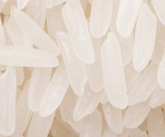 Jasmine Rice - Jasmine rice, sometimes known as Thai fragrant rice, is a type of long grain rice with a long kernel and slightly sticky texture when cooked. Use it to infuse a subtle jasmine flavor and aroma into your dishes.
Jasmine Rice - Jasmine rice, sometimes known as Thai fragrant rice, is a type of long grain rice with a long kernel and slightly sticky texture when cooked. Use it to infuse a subtle jasmine flavor and aroma into your dishes.
Ref:http://www.webstaurantstore.com/guide/658/types-of-rice.html



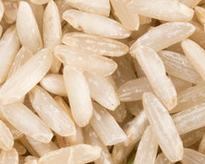

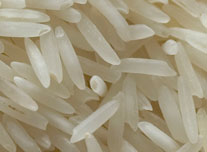
No comments:
Post a Comment